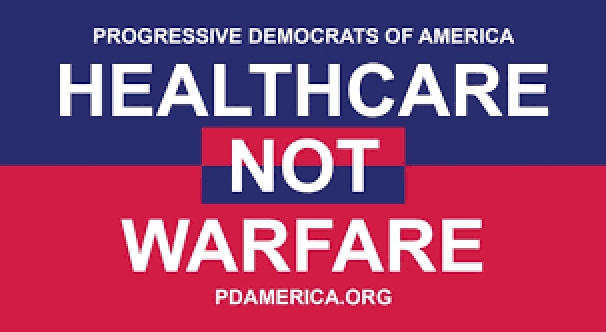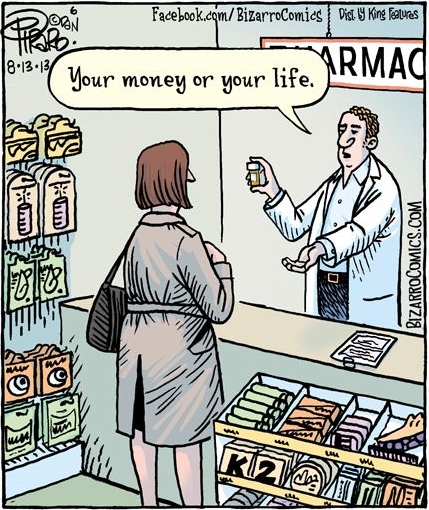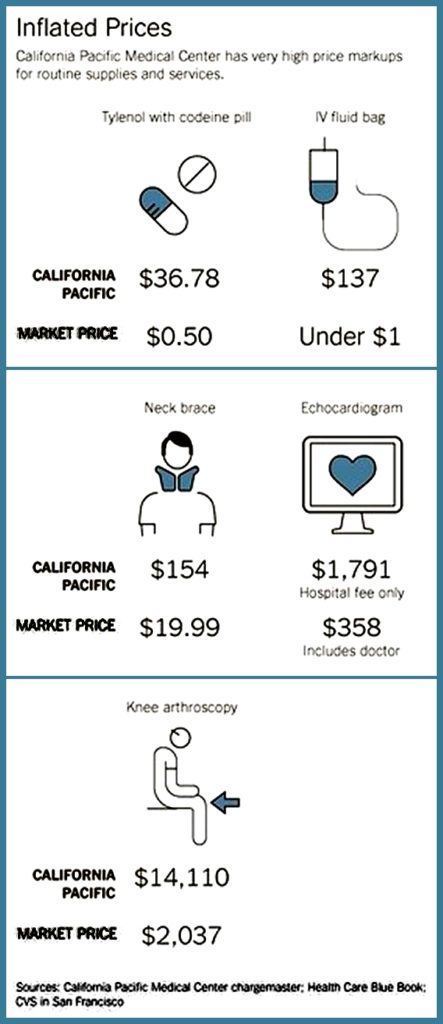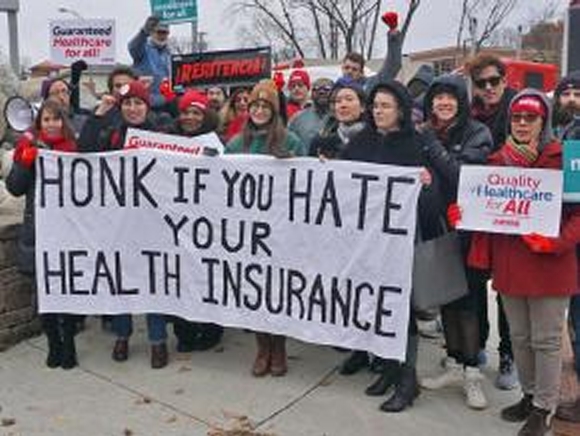
What’s wrong with the for-profit U.S. healthcare system? Let’s start with the basics: Patients deceived by the health industry’s public relations operations into believing that the inflated insurance premiums, the absurdly expensive copays and deductibles are justified by having the best healthcare system in the world. Unfortunately, that’s fake news. US health care is without doubt the world’s most expensive gobbling up $3.65 trillion last year. But it is far from the best. While other countries experienced an upsurge in life expectancy in 2017, the U.S. Centers for Disease Control and Prevention reported that U.S. life expectancy dropped for the second year in a row. As U.S. healthcare experts searched for answers, one study found, “A leading cause is fatal drug overdoses – fueled by the opioid epidemic …Deaths from alcoholism and suicides have also increased, what some call deaths of despair.” (Dr. Steven H. Woolf of Virginia Commonwealth University). Turns out that suicide (death of despair) has become the tenth leading cause of death in the U.S.
Raising the death toll among U.S. patients are medical mistakes that have become the third leading cause of death, claiming over a quarter million lives every year. Other causes of unnecessary death abound in the U.S. where the free market is king and patients are commodities exploited for profit.
The most profitable sectors of the healthcare industry, the drug companies rely on the unregulated free-for-all healthcare economy to keep drug prices climbing. All it takes is a lot of money spread around the halls of congress. In 2018, Big Pharma (the pharmaceutical lobby) and individual drug companies spent $280 million. According to Open Secrets.org, in 2017, the entire healthcare industry spent $555 million lobbying Congress and the White House. A report prepared by the National Research Council and the Institute of Medicine, described the benefits patients received: poorest health outcomes among sixteen developed nations.
Even in that formerly safe harbor of employer insurance, complaints among workers and employers is growing as insurance companies continue raising the prices of premiums, deductibles and copays. The 56% of Americans covered by employee insurance are paying more and getting less. As employee premiums in the last decade have increased 55% and deductibles 212%, most employers have passed the cost onto their workers. Ten to twelve percent of the average worker’s paycheck is eaten up with premiums, deductibles and copays, leaving a large hole in the household budget. More than one-quarter of adults skipped medical care in 2018 because they couldn’t afford it. Eighty percent of American families live paycheck to paycheck (CNBC) and have been forced to reduce their spending on food, clothes and household items to pay their medical bills. As prices to protect themselves and their families from medical disasters rise, more and more hard-working Americans find themselves one serious illness away from financial ruin.

Among the many sectors of the criminogenic healthcare industry, Big Pharma is by far the poster child for price-gouging.
Baby M was born with spinal muscular atrophy (SMA), a rare inherited muscle-wasting disease that kills affected infants before the age of 2. His parents’ insurance company coughed up the $2.1million dollars the therapy cost, making it the most expensive treatment in the world. Because the drug is so new, no one knows if it will permanently stop the disease or in case of a relapse if the insurance company will pay for another round. That didn’t stop the CEO of Novartis from bragging that his company had actually priced the drug “far lower” than the four to five million the company thought it was worth. “The industry is masterful at creating certain facts which become immutable even though they’re not.” (Dr. Peter B. Bach, the Center for Health Policy and Outcomes at Memorial Sloan Kettering Cancer Center). In addition, Novartis unveiled a plan to allow insurers to pay for the drug over 5 years like a mortgage. Shortly after the FDA approved the treatment, Novartis executives were off on a road trip to delude the public into believing that greed and larceny are the hallmarks of the finest healthcare in the world.
| Baby M was born with spinal muscular atrophy (SMA), a rare inherited muscle-wasting disease that kills affected infants before the age of 2. His parents’ insurance company coughed up the $2.1million dollars the therapy cost, making it the most expensive treatment in the world. Because the drug is so new, no one knows if it will permanently stop the disease or in case of a relapse if the insurance company will pay for another round. That didn’t stop the CEO of Novartis from bragging that his company had actually priced the drug “far lower” than the four to five million the company thought it was worth. “The industry is masterful at creating certain facts which become immutable even though they’re not.” (Dr. Peter B. Bach, the Center for Health Policy and Outcomes at Memorial Sloan Kettering Cancer Center). In addition, Novartis unveiled a plan to allow insurers to pay for the drug over 5 years like a mortgage. Shortly after the FDA approved the treatment, Novartis executives were off on a road trip to delude the public into believing that greed and larceny are the hallmarks of the finest healthcare in the world. |
Is there a drug-taking adult in the U.S. (where half of Americans take at least one prescription drug) surprised to learn that, according to a congressional report, “the prices of many of the most popular drugs increased at nearly ten times the cost of inflation from 2012 — 2017.” More to the point, drug costs began exploding in 1992 when Congress passed the Prescription Drug User Fee Law that required drug companies to pay most (currently 75%) of the cost of the FDA approval process — “Instead of a regulator and a regulated industry, we now have a partnership…tilting the agency [FDA] away from a public health perspective to an industry friendly perspective.” (Dr. Michael Carome, Public Citizen)
| He was a college student-athlete who loved to run. Suddenly he started experiencing muscle weakness and within three months was in a wheel chair. He was diagnosed with a rare auto-immune disease treatable with a drug made by a small drug company. Since it was inexpensive to make, the company provided it to patients free of charge. That changed when the company was purchased by Catalyst, a big drug company. After making some minor alterations in the formula, the FDA allowed them to charge big bucks for the drug that was essentially unchanged from the free version. When the young man took the drug, he was doing cartwheels in an hour. The price to give him back his life—$500,000. He was also one of the lucky ones. His dad’s employment insurance covered the cost. His mother was far from grateful— “Catalyst took advantage of my son’s illness to make millions from a drug it didn’t discover.” |

Big Pharma continues to be an equal opportunity conniver with price hike scams that hit every corner of the market. During House of Representatives hearings on May 16, Gilead CEO Daniel O’Day was asked a simple question: Why does a life-saving HIV drug that cost $8 a month in Australia cost $1,780 a month in the U.S. Particularly galling, the development of this drug, Truvada, was ”almost fully funded by U.S. taxpayers,” with the U.S. holding a patent on it since 2015. In four years Gilead has made billions in profits from Truvada, but the U.S. has never tried to claim its share of the profits. (Washington Post)
Thanks to hefty lobbying and generous “contributions” to their campaigns, Congress has passed up every opportunity to enact legislation giving Medicare the right to negotiate drug prices. In the absence of any regulation, the drug market has abandoned pricing models where the cost to produce a drug is the basis for pricing to an “all that the market will bear” approach. Take the case of insulin, a life-saving drug discovered in the 1920s and which has withstood the test of time and required no expensive fixes for over twenty years. Its price doubled between 2002-2016. “One out of 4 diabetes patients in our country cannot afford their insulin.” (Kamala Harris at a CNN town hall event 4/22/19)
The cat is out of the bag for another secret pricing arrangement to enrich executives and shareholders of large hospitals. A RAND analysis revealed that in 2017 hospitals billed private insurance companies almost two-and-one-half times the prices these same hospitals charged Medicare. Since one-third of the $3.65 trillion the U.S. spends on health care goes to pay hospitals, the chasm between what the federal government pays and the amount the private sector pays results in billions of healthcare dollars wasted while prices for consumers continue their upward spiral.
To counteract the lack of regulation that makes this corruption possible, Senator Bernie Sanders and Representatives Ro Khanna and Elijah Cummings introduced in the House and Senate —The Prescription Drug Price Relief Act of 2019 that would alter the prescription drug landscape in important ways. Sanders explained “if the pharmaceutical industry will not end its greed, which is…killing Americans, then we will end if for them.” The bill is meant to “peg the price of prescription drugs in the United States to the median price in five major countries Canada, the United Kingdom, France, Germany and Japan [and] direct the Secretary of Health and Human Services to negotiate lower prices for prescription drugs under Medicare. A companion measure The Affordable and Safe Prescription Drug Importation Act would allow Americans “to import safe, low-cost medicines from Canada and other major countries. Not likely to pass a Republican Senate or even a center-right Democratic House, its sponsors hold out hope it will send the message that the days of exorbitant drug price inflation are numbered. Rep. Elijah Cummings (D-MD) chairman of the House Committee on Oversight and Reform, is more optimistic “there is strong bi-partisan consensus that we must do something to rein our out-of-control price increases.”
Ask Nancy Pelosi, Democratic Speaker of the House and worth $16 million in her own right, how she feels about the unbridled greed of the drug companies. She is hyping her own bill to “fix” drug costs. Toeing the phony progressive line, she has stuffed her bill with back door escape clauses. It would only apply to certain high cost drugs, and would replace negotiations over drug prices with arbitration, a voluntary and nonbinding system allowing drug companies to opt out without penalty. Sounds like a sweetheart deal for Pharma.
U.S. healthcare in a nutshell: a corrupt pay-to-play shell game that leaves hundreds of thousands untreated, millions uninsured and underinsured and over one-half million bankruptcies linked to medical debt every year. Even for an exceptional nation that’s a mighty big exception to the general rule that exists in every other advanced country on the planet —that citizens have a right to as much health care as they need without worrying about the cost.

1,064 total views, 2 views today
